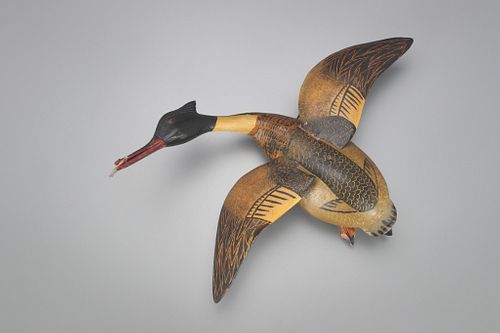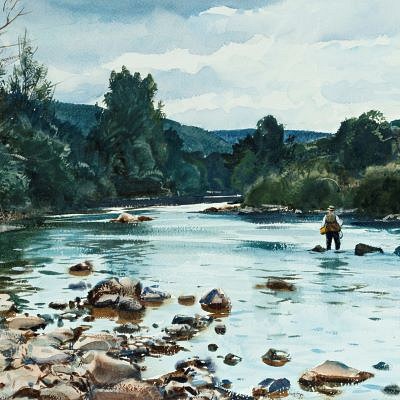The Mackey Hudson Flying Merganser, Ira D. Hudson (1873-1949)
About Seller
20 Winter Street
Pembroke, MA 02359
United States
Founded in 2005, Copley Fine Art Auctions is a boutique auction house specializing in antique decoys and American, sporting, and wildlife paintings. Over the course of the last two decades, the firm has set auction records for not only individual decoy makers, but also entire carving regions. Copley...Read more
Two ways to bid:
- Leave a max absentee bid and the platform will bid on your behalf up to your maximum bid during the live auction.
- Bid live during the auction and your bids will be submitted real-time to the auctioneer.
Bid Increments
| Price | Bid Increment |
|---|---|
| $0 | $50 |
| $1,000 | $100 |
| $2,500 | $250 |
| $5,000 | $500 |
| $10,000 | $1,000 |
| $25,000 | $2,500 |
| $50,000 | $5,000 |
About Auction
Feb 20, 2021
Lots 293-596 Copley Fine Art Auctions cinnie@copleyart.com
- Lot Description
Ira D. Hudson (1873-1949)
Chincoteague, VA, c. 1935
17 1/2 in. long, 22 in. wingspan
A testament of his fondness for this carving, William J. Mackey Jr. hung it alongside a black duck and pintail above a fireplace mantle in his Belford, New Jersey, home.
Referencing this carving in her 1974 book, "American Decoys," Quintina Colio writes, "Ira Hudson, the great decoy maker of Chincoteague, was the most prolific carver from Virginia. Despite his working steadily to fill orders to support his wonderful family, he took time to make these fanciful decorations. His record stands that he always produced a most collectible work of art."
This widely published Hudson example, with its open bill with fish, stylish crest, turning motion, and stylish paint, is among the maker's best flyers. While all of Ira Hudson's children were involved in the family's carving business, his sons Norman and Delbert (1928-1981) were the most involved. Showing the Hudsons' most lively paint, this merganser was likely painted by Delbert.
The bird is marked with the Mackey Collection ink stamp.
Excellent original paint with minor wear, the original mandible has been reset. Chip at back side of neck seam, minimal chipping at untouched wing seams.
Provenance: William J. Mackey Jr. Collection
William K. du Pont Collection
Literature: Quintina Colio, "American Decoys," Ephrata, PA, 1972, p. 95, exact decoy illustrated in reverse. Richard A. Bourne Co., Inc., "Very Rare and Important American Bird Decoys from the Collection of the late William J. Mackey Jr. of Belford, New Jersey," Hyannis, MA, 1973, Sessions I & II, lot 573, exact decoy illustrated. William H. Purnell Jr., Back East In the Midwest Out West, Decoy Magazine, September/October 1991, p. 9, exact decoy above mantel. Anne Small, Masters of Decorative Bird Carving, Tulsa, OK, 1981, p. 65, exact decoy illustrated.Please email condition report requests to colin@copleyart.com. Any condition statement given is a courtesy to customers, Copley will not be held responsible for any errors or omissions. The absence of a condition statement does not imply that the lot is in perfect condition.Condition
- Shipping Info
-
Copley Fine Art Auctions does not handle the shipping of any items. Shipping is the sole responsibility of the buyer. Once your payment has cleared and we have received your shipping form, items may be released for shipment. Copley Fine Art Auctions, LLC shall have no liability for any loss or damage to such items. Buyers should allow up to four weeks for shipment.
Please be aware that internet bidders may NOT not pick up their items at the sale. Items will be available for pick up by appointment or by shippers five days after the sale.
-
- Buyer's Premium



 EUR
EUR CAD
CAD AUD
AUD GBP
GBP MXN
MXN HKD
HKD CNY
CNY MYR
MYR SEK
SEK SGD
SGD CHF
CHF THB
THB














